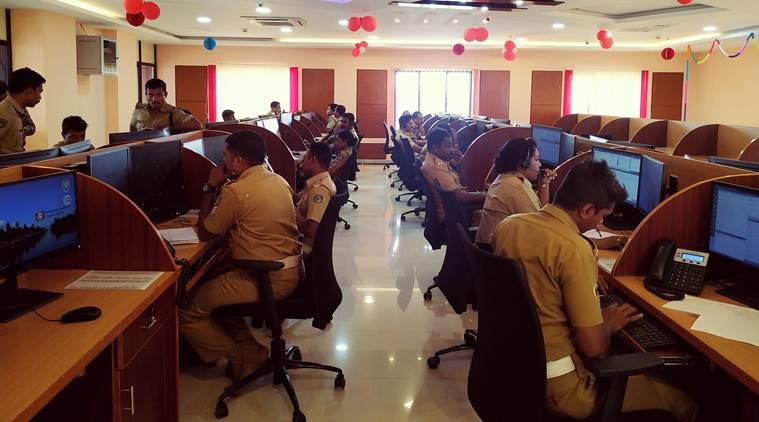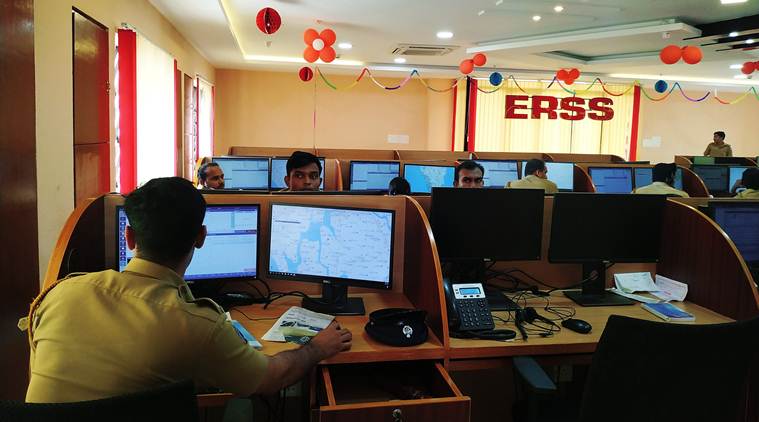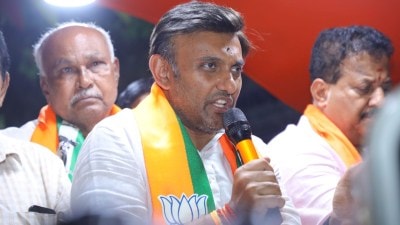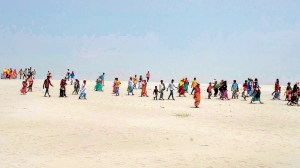- India
- International
With pan-India helpline 112, police response to distress calls in Kerala gets faster and transparent
The project, funded by the Union Ministry of Home Affairs, was rolled out on February 19 this year with the aim of bolstering police response systems to distress calls landing on 112, a new, pan-India number.
 Instead of dialling different helpline numbers such as police (100), fire force (101) and ambulance (112), the public can now call on 112 for quick, unified response services. (Express Photo by Vishnu Varma)
Instead of dialling different helpline numbers such as police (100), fire force (101) and ambulance (112), the public can now call on 112 for quick, unified response services. (Express Photo by Vishnu Varma)
On a recent muggy afternoon on the sixth floor of the Kerala Police headquarters in Thiruvananthapuram, there were all kinds of phone calls coming in.
“Are you saying there’s a snake inside the postbox? Is it dead?” an officer responded to a caller from Thiruvananthapuram city.
In another corner of the room, an officer tended to a different problem from Thiruvalla town in Pathanamthitta district. “Okay, so there’s an intoxicated man creating a brawl at your friend’s house. Tell your location please and we’ll send an officer shortly,” he shouted into the phone.
 The live movement of every police vehicle, available in a city or district, through GPS can be viewed by officers inside the control room. (Express Photo by Vishnu Varma)
The live movement of every police vehicle, available in a city or district, through GPS can be viewed by officers inside the control room. (Express Photo by Vishnu Varma)
These are the scenes at the state-of-the-art, centralised Emergency Response Support System (ERSS) control room of the Kerala Police, working round-the-clock, tending to complaints of all nature from the public. The project, funded by the Union Ministry of Home Affairs, was rolled out on February 19 this year with the aim of bolstering police response systems to distress calls landing on 112, a new, pan-India number. Instead of dialling different helpline numbers such as police (100), fire force (101) and ambulance (112), the public can now call on 112 for quick, unified response services. The ERSS project is in line with the recommendations of the Justice Verma committee in the backdrop of the 2012 Delhi gangrape case.
The ERSS software, developed by the Centre for Development of Advanced Computing (C-DAC), Pune, involves multiple levels of intervention. All distress calls and text messages to 112 from across Kerala land first at the centralised control room in Thiruvananthapuram. The details and location of each distress call is jotted down, fed back into the software and re-routed to the respective district control rooms in less than a minute. Officers at the district control rooms, upon seeing the distress call light up on their computer systems, can identify the approximate location of the caller and subsequently send the nearest police vehicle to the spot. The live movement of every police vehicle, available in a city or district, through GPS can be viewed by officers inside the control room.Additionally, there are four officers assigned to each police range to assess feedback from callers and submit reports on the police response time. This way, errant officers failing to resolve the issue on time can be hauled up.

 As compared to the police helpline 100, on which lines would be perennially busy due to dropped calls, the new system keeps the line free for the actual victims. (Express Photo by Vishnu Varma)
As compared to the police helpline 100, on which lines would be perennially busy due to dropped calls, the new system keeps the line free for the actual victims. (Express Photo by Vishnu Varma)
In a large freshly-painted room at the police headquarters, around 23 male and female officers sat diligently scanning the computer systems in front of them, waiting for the phones to ring. The computers, loaded with the C-DAC software, allow an officer to plot a caller’s location on a Google Map and enter the details of the incident. After the case is routed to the respective district control room, the officer in Thiruvananthapuram can continue to track the ‘event’ in real-time and keep a tab on whether the police have responded to the incident. This is a departure from the old system where officers would respond to callers dialling ‘100’ and then use a wireless to despatch a vehicle. In the old mechanism, there was little scope for monitoring real-time and therefore any space for transparency. As of now, 11 of the 19 police divisions in the state have routed all calls from 100 to 112.
“The system is transparent and everything is tracked right from the time the call lands on our computer. It helps the police take action faster,” said Ashokan Chembadan, a Deputy Superintendent of Police, in-charge of the control room.
The ERSS network is completely virtual and replaces the old system where officers handle calls on phone manually and then despatch vehicles through the wireless. With ERSS, there is a digital footprint for every distress call, right from the moment it lands to the time the local police on the ground visit the spot and file a closure report on the status of the incident. As compared to the police helpline 100, on which lines would be perennially busy due to dropped calls, the new system keeps the line free for the actual victims.
Officers, taking calls, said the ERSS platform was particularly helpful during this year’s floods and landslides in the state to help out people stuck in homes surrounded by rising waters. “We were able to send ambulances and medical help to a lot of people on time,” said Shijin, an officer.
If road accidents and clogging of traffic take the top two spots for the most common nature of distress calls, harassment of women, particularly that of physical assault by drunken men, takes the third spot. NCRB data in 2014 had shown that 59 per cent of crimes in Kerala are related to alcohol abuse.
“We get a lot of calls from women complaining of abuse from their drunken husbands, fathers and brothers. Many of these calls come post-midnight and more on weekends and holidays. In such cases, we despatch our officers immediately to solve the issue,” said Beena, one of the four officers in-charge of each police range deputed to look into the feedback mechanism.
In one such distressing recording of a phone call, a victim could be heard crying into the phone, “Sir, please come quickly. My brother is beating me to death.”
 The ERSS project is in line with the recommendations of the Justice Verma committee in the backdrop of the 2012 Delhi gangrape case. (Express Photo by Vishnu Varma)
The ERSS project is in line with the recommendations of the Justice Verma committee in the backdrop of the 2012 Delhi gangrape case. (Express Photo by Vishnu Varma)
Interestingly, Beena adds that a lot of the women at home, who bear the brunt of domestic violence by their husbands, don’t want the police to file a case. “They want us to just intimidate their husbands. Some of them have even called back to say that after we intervened, their husbands don’t beat them anymore,” she said.
An officer at the Kochi police control room has drawn up a mental pattern of such incidents. “By 5 pm, these men, mostly daily wagers, would start queueing up in front of the liquor shop after work. And by 9 pm, they would have drank till the last drop. Post 10 pm, after they reach home, the assault starts and soon enough, we get calls,” an officer said, without dilvulging his name.
The more serious cases, where victims want to press charges, get transferred to the police stations where the law takes its course.
Aside from dialling 112, victims can also send text messages to the number and use the panic button on the mobile app specially designed by C-DAC. There are also talks between the MHA and the mobile service providers on providing the police with the exact location of the victim using his/her cell tower.
Apr 27: Latest News
- 01
- 02
- 03
- 04
- 05








































